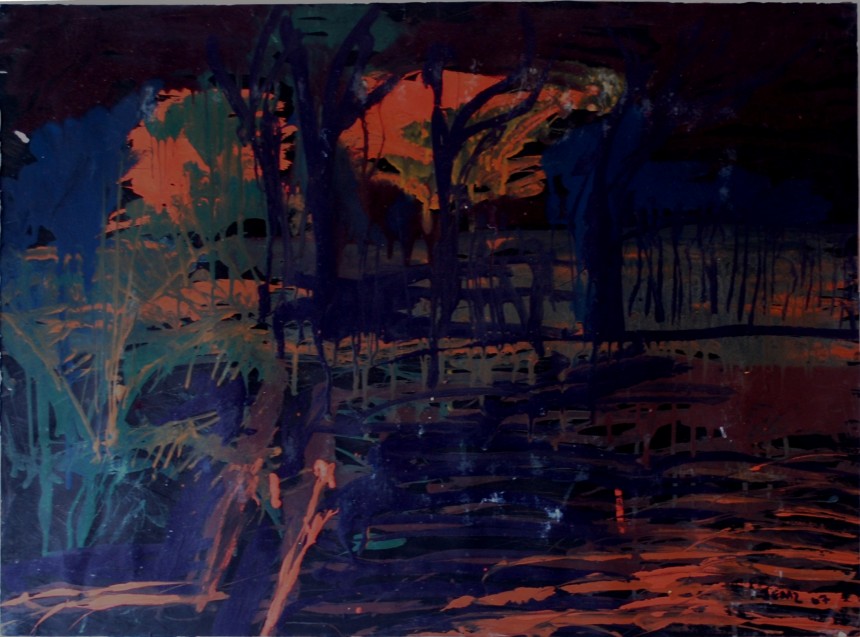George Tomy was born on March 25, 1982 in Harare. He is only boy in a family of five. He initially studied art at the National Gallery of Zimbabwe whilst doing his ‘O’ and ‘A’ levels at Seke 3 High School. George studied in fine art at Harare Polytechnic. His theme is “Night Mood” or “Night life”. His work is experimental, as he employs abstract expressions and he uses ethnic colors. George’s majors are painting and sculpture, and he has exhibited at many group exhibits. Also, he has done live graffiti performance at Harare International Festival of Arts (HIFA).
Harare polytechnic visual art graduands exhibit their works
December 18, 2006: Seven Harare Polytechnic visual arts graduands have demonstrated their lifelong commitment to artistic expression by exhibiting their examination work at the U.S. Embassy Public Affairs Section in Eastgate. The students completed a two-year course in visual arts at the Polytechnic. The exhibition, which began in early December, runs until February 28th 2007.
Among the seven are two female, Virginia Chihota and Portia Zvavahera, (pictures attached) who have taken their gender roles to the art world.
“It’s a life long commitment,” says Virginia. “Painting has always been my passion.”
Virginia, who focused on print making and textiles during her course, brings life in print marking with experiments collaborating different techniques of printing with found objects. Her artworks seem to be personal experiences witnessed by her titles and subjects. It seems as if she is painting or printing her life. In one of her works titled “Inga ndinotaurika neni wani” (you are free to speak to me) leaves art lovers with a keen interest on the artist’s personality.
Another female artist, Portia, finds inspiration in communicating the behaviour of children.
“I want to champion the rights of children in artistic terms. This exhibition is an opportunity for us as we enter the world out there. For us exhibitions are a way to market our talents,” she says shyly.
Portia shows a big passion for children and her brush strokes reflects these feelings. Her paintings reflect a larger degree of personal freedom like a child, who has an awesome amount of concentration span when looking at an adult. Her brushstrokes seem to be overlapping one after the other giving them a joyous mood you will find in kids as they mimic the expressions of their peers. She also uses newspaper cuttings to her advantage- the result of which is a visual texture with the effect of keeping audiences glued as they attempt to link word to design and vice versa. Witness her brushstrokes and composition.
The two female students, along with colleagues, Fungai Mwale, Tongesai Machiri, George Tom graduated from the National Gallery Visual Arts (BAT) School where they spent two years before proceeding to Harare Polytechnic in 2005. They automatically enrolled as second year students joining two other colleagues, Samuel Ziso Mudiwa and Kumbulani Zamuchiya.
As the graduands look to the future, they have hope about their prospects. This is aptly depicted in the paintings by Fungai Mwale’s print marking and paintings whose theme at the exhibition is “hope”. In his paintings, Fungai expresses himself and the community that brought him up.
In a number of his paintings and prints you find bicycles.
He explains: “hope is found in anyone even someone fixing a tyre puncture”.
Through this logic Fungai has managed to develop new techniques with his brush marks, which are very controlled. Fungai’s passion to find freedom is also witnessed in colour. To him, colour expresses freedom.
Zimbabwe is gaining world wide reputation for outstanding stone sculpture and there are several stone sculptures at the exhibition by Samuel Ziso Mudiwa.
At the U.S. Embassy’s Public Affairs Section, the students’ work is exposed to an average traffic of 200 people each day with visitors ranging from prospective students to American universities and researchers using the library.
Relations between the Harare Polytechnic and the U.S. started when one of their tutors at the visual arts department went on a three-year exchange visit with the Virginia Commonwealth University ###
